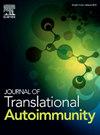IL-7和自身MHC识别等体内平衡信号诱导外周辅助T细胞的发育,这些细胞在类风湿性关节炎的关节中富集
IF 3.6
Q2 IMMUNOLOGY
引用次数: 0
摘要
目的长期以来,T细胞稳态失调一直被认为与类风湿性关节炎(RA)的发病机制有关,在类风湿性关节炎的关节中,外周辅助性T细胞(Tph)聚集并形成异位淋巴器官。我们研究了平衡信号是否参与了 Tph 细胞的发育。方法用 IL-7 培养人外周血单核细胞,IL-7 是 T 细胞平衡的关键细胞因子。通过流式细胞术、基因表达和功能分析评估了Tph样细胞的发育情况。研究了Tph样细胞对RA滑液(RASF)的趋化作用以及RASF对Tph样细胞发育的影响。来自自身-MHC 识别和 CD28 协同刺激的信号也参与其中。IL-7诱导的Tph样细胞(IL-7-Tph)能产生CXCL13和IL-21,并帮助B细胞产生IgG。全面的基因表达分析进一步证实了与 RA 关节中 Tph 细胞的相似性。IL-7-Tph细胞对来自RA患者的滑液(RASF)表现出趋化性,RASF促进了IL-7-Tph细胞的发育,而这些细胞也是从非炎症关节中的CD4 T细胞中诱导出来的。本文章由计算机程序翻译,如有差异,请以英文原文为准。
Homeostatic signals, including IL-7 and self-MHC recognition, induce the development of peripheral helper T cells, which are enriched in the joints of rheumatoid arthritis
Objective
Dysregulated T cell homeostasis has long been implicated in the pathogenesis of rheumatoid arthritis (RA), in the joint of which peripheral helper T (Tph) cells accumulate and form ectopic lymphoid organs. We examined whether homeostatic signals are involved in the development of Tph cells.
Methods
Human peripheral blood mononuclear cells were cultured with IL-7, the critical cytokine for T cell homeostasis. Development of Tph-like cells was assessed by flow cytometry, gene expression, and functional analysis. Chemotaxis of the Tph-like cells to RA synovial fluid (RASF) and the effect of RASF on the development of Tph-like cells was examined.
Results
PD-1highCXCR5- Tph-like cells developed from human peripheral blood CD4 T cells after proliferation in response to IL-7. Signals from self-MHC recognition and CD28 co-stimulation were also involved. The IL-7-induced Tph-like (IL-7-Tph) cells produced CXCL13 and IL-21 and helped B cells produce IgG. Comprehensive gene expression analysis further supported the similarity with Tph cells in RA joint. IL-7-Tph cells exhibited chemotaxis toward synovial fluid from RA patients (RASF), and RASF promoted the development of IL-7-Tph cells, which were also induced from CD4 T cells residing in non-inflamed joints.
Conclusions
Our results demonstrate an antigen-nonspecific developmental pathway of Tph cells triggered by homeostatic signals and promoted by the local environment of RA, which accounts for the accumulation of Tph cells in inflamed joints.
求助全文
通过发布文献求助,成功后即可免费获取论文全文。
去求助
来源期刊

Journal of Translational Autoimmunity
Medicine-Immunology and Allergy
CiteScore
7.80
自引率
2.60%
发文量
33
审稿时长
55 days
 求助内容:
求助内容: 应助结果提醒方式:
应助结果提醒方式:


